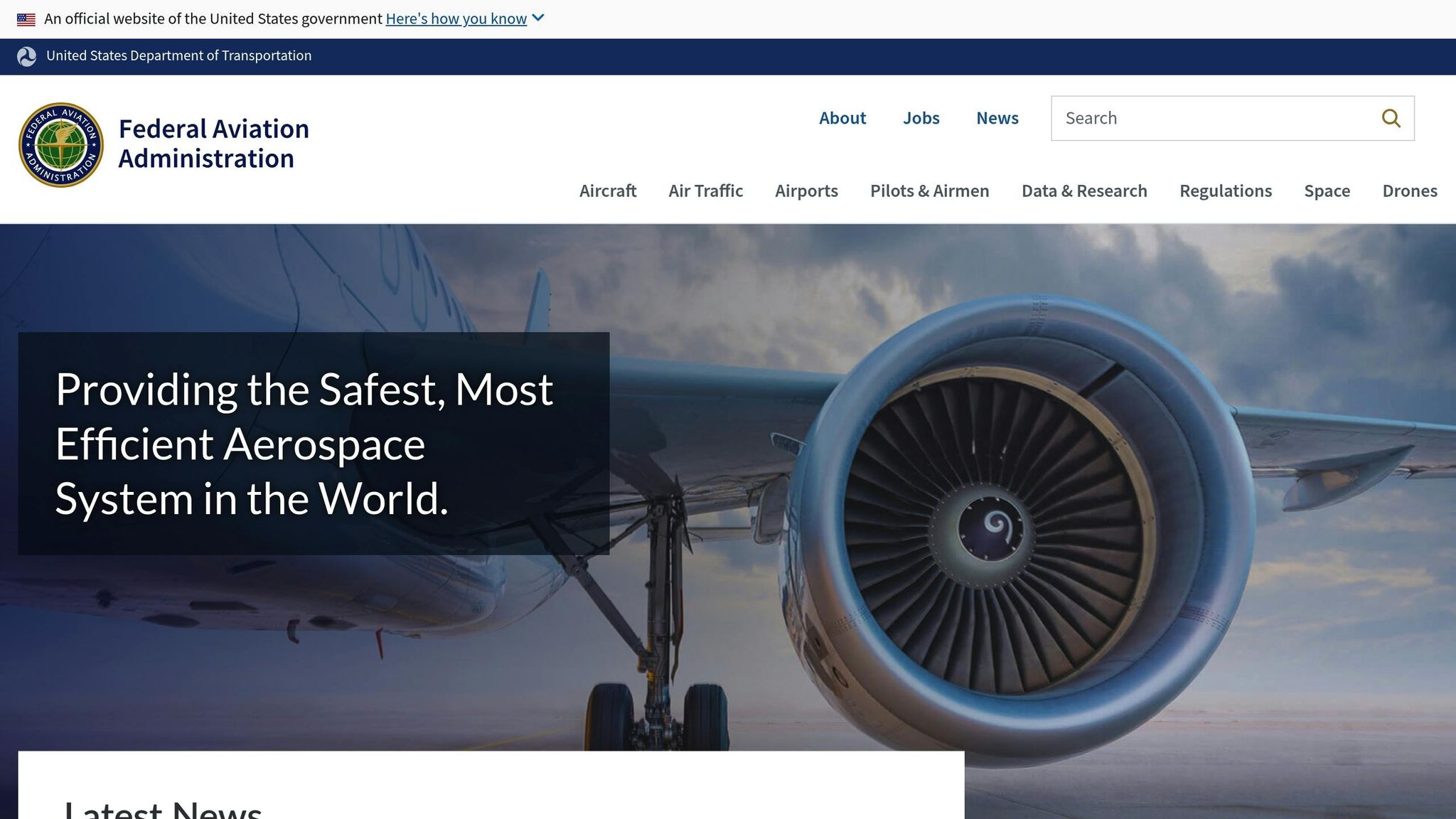Drones can transform how real estate agents market properties, offering stunning aerial views and virtual tours. But using them comes with strict legal rules. Here’s a quick guide:
- Federal Requirements:
- Get FAA Part 107 certification to fly drones commercially.
- Register drones over 0.55 lbs.
- Follow rules like keeping drones in sight and adhering to airspace restrictions.
- Texas Privacy Laws:
- Don’t capture or share images of private property without consent.
- Violations can lead to fines up to $5,000 per image or more.
- Best Practices:
- Hire FAA-certified drone operators.
- Get written consent from property owners.
- Avoid flying over restricted areas like correctional facilities and sports venues.
Staying compliant protects your business and reputation while helping you stand out in a competitive market.
MOST Legal Drone Workflow for Real Estate | 2024 Updates!
Texas Drone Regulations: Key Rules for Real Estate Agents
If you’re a real estate agent in Texas planning to use drones, you’ll need to follow both FAA and state-specific rules. These regulations cover everything from getting certified to knowing where you can and can’t fly.
Federal Aviation Administration (FAA) Requirements
To use a drone for commercial purposes – like taking photos of properties – you must comply with the FAA’s Part 107 Small UAS Rule. The first step is obtaining a Remote Pilot Certificate. To qualify, you need to:
- Be at least 16 years old
- Be proficient in English
- Demonstrate the ability to operate a drone safely
Start by creating an IACRA profile to get your FAA Tracking Number. Then, schedule and pass the Unmanned Aircraft General – Small (UAG) Knowledge Test at an FAA-approved testing center. The test costs about $175 and covers topics like airspace rules, weather, and emergency procedures. Plan to spend around 20 hours studying for it. Once you pass, submit FAA Form 8710-13 through IACRA to complete your certification.
Additionally, you must register any drone weighing over 0.55 lbs (250 g) through the FAA’s FAADroneZone. Registration costs $5 and is valid for three years. Always keep your drone within your visual line of sight, follow Remote ID requirements, and complete recurrent online training every two years.
Beyond federal rules, Texas adds its own layer of regulations, particularly around privacy.
State-Specific Laws for Texas
Texas law, specifically the Texas Privacy Act (Government Code Section 423), focuses on addressing privacy concerns related to drone use. This law prohibits unauthorized drone surveillance, and violations can lead to fines of up to $5,000 per illegal image or recording.
For licensed real estate brokers, the law allows the use of drones to capture images for marketing, selling, or financing properties, as long as no individuals are identifiable in the photos. Always get consent from property owners before photographing or filming their property. The Texas Film Commission emphasizes the importance of flying responsibly:
"The Texas Film Commission encourages productions to refer to the online resources below to learn more about responsible and safe flying in accordance with Federal Aviation Administration (FAA), state and local regulations."
In addition to privacy rules, there are specific areas where drone flights are restricted.
Prohibited and Restricted Flight Zones
Certain zones in Texas are off-limits for drones. For example, you can’t fly over correctional facilities, and flights over sports venues are restricted in some cases. Flying below 400 feet over critical infrastructure is considered a Class B misdemeanor.
Local governments, such as Harris County, may have additional restrictions, like limiting drone operations to specific areas in precinct parks. Drones must always stay within your line of sight unless you have written authorization. Special events and municipal rules can also impose further restrictions.
On the federal side, the FAA enforces temporary flight restrictions (TFRs) during major events like sporting matches, space launches, or when the President is in town. To stay informed, use tools like the FAA’s B4UFLY app or their "Visualize it: See FAA UAS Data on a Map" website. DJI also offers a GEO Zone Map that shows areas where drone takeoffs are restricted.
While private landowners can’t enforce FAA-designated "No Drone Zone" signs, they can restrict drone takeoffs and landings on their property. Always check with local authorities to ensure you’re following any additional rules that may apply to your area.
Privacy and Consent in Drone Photography
In addition to federal and state flight regulations, understanding privacy laws is essential to avoid hefty fines or legal troubles when capturing aerial footage of properties. Texas, in particular, has stringent privacy protections, and violations can result in severe consequences.
Understanding Privacy Laws
The Texas Privacy Act (Government Code Section 423) establishes clear limits on drone photography, exceeding federal regulations. Taking images of individuals or private property without their consent is classified as a Class C misdemeanor. Civil penalties can reach $5,000 for possessing illegal surveillance materials and up to $10,000 for distributing them, as specified under the Act. Additional misdemeanor charges may apply if you possess, share, display, or use images captured unlawfully.
The term "surveillance" is somewhat ambiguous in the law, which means you need to proceed with caution. The legislation aims to shield individuals from unwarranted observation, and courts may interpret actions broadly.
For real estate professionals, there is an exception: you’re allowed to capture images for the marketing, sale, or financing of real property. However, this exception only applies if no individuals are identifiable in the footage.
Alicia Calzada, an attorney for the National Press Photographers Association, clarified during legal discussions:
"Contrary to the characterization of the court, we have never claimed a sweeping First Amendment right to use unmanned aerial drones in a manner that constitutes an invasion of privacy. Invasion of privacy was a violation of the law before this statute was passed, and continues to be so, and we have never claimed otherwise."
James Hemphill, an attorney based in Austin, added:
"The government can’t unduly restrict the ability to gather news without some kind of important countervailing interest".
Getting Consent from Property Owners
Given these strict rules, obtaining explicit consent is critical. Always secure written consent from property owners before flying a drone over their property. This applies not only to the property you’re working on but also to any neighboring properties that may appear in your footage.
When planning your flight, avoid capturing areas where there’s a reasonable expectation of privacy. For example, stay clear of fenced backyards, pool areas, or other private spaces. It’s also a good idea to inform neighbors ahead of time to prevent misunderstandings.
Be mindful of where your drone’s camera is pointed. Avoid recording private spaces like windows, yards, or pools. If your footage unintentionally includes people or identifiable details such as license plates or house numbers, make sure to edit them out before sharing the content online. When using drone footage in MLS listings, blur any identifying features.
Failing to get proper consent has consequences beyond fines. Images captured illegally cannot be used as evidence in legal proceedings, which could complicate future disputes. While prosecutions for drone law violations are reportedly rare, the penalties for non-compliance can be severe when enforcement does occur.
To protect yourself and your clients, ensure you have clear agreements with drone operators regarding the ownership and use of imagery. Professional services like HomeJab can handle these compliance concerns for you. They work with FAA-certified pilots who are well-versed in both federal and state regulations. Taking these precautions not only safeguards your business but also builds trust with your clients, forming an essential part of responsible drone operations.
sbb-itb-82c5f45
Best Practices for Real Estate Agents Using Drones
In Texas, navigating strict drone regulations is crucial for capturing stunning aerial property footage while staying within the law. Here’s how real estate agents can make the most of drones without running into compliance issues.
Hiring a Licensed Drone Operator
The safest and most reliable way to use drones for commercial real estate photography is to hire a certified drone pilot. Under the FAA’s Part 107 Small UAS Rule, anyone operating a drone for commercial purposes must hold a valid Remote Pilot Certificate. When selecting a drone operator, it’s essential to verify their certification and ensure they’ve completed recent training.
Beyond certification, confirm that the drone they use is FAA-registered and meets all recurrent training requirements. Operators should also carry adequate insurance to cover privacy concerns, property damage, or injury claims. Additionally, clarify copyright and image usage rights upfront to avoid misunderstandings. Keep in mind that failing to adhere to FAA regulations could result in steep fines – up to $75,000 per violation.
Planning Flights for Maximum Impact
Careful flight planning is key to creating visually striking footage while staying compliant. Start by checking the weather, as Texas’s rapidly changing conditions can pose safety risks.
Pay close attention to airspace restrictions. For example, drones are prohibited from flying over correctional facilities, sports venues, and critical infrastructure below 400 feet. Local rules can add another layer of complexity. In Harris County, for instance, parks may have their own drone regulations. For Texas State Parks, a filming permit is generally required unless operating in designated zones like Lake Whitney and San Angelo State Parks.
To capture the best visuals, plan flights during optimal lighting conditions – golden hour, shortly after sunrise or before sunset, offers warm tones and dramatic shadows that enhance property appeal. Also, double-check local ordinances to avoid any unexpected restrictions in your chosen flight area. These steps not only elevate the quality of your footage but also help ensure smooth, trouble-free drone operations.
Using Professional Services Like HomeJab
If navigating drone regulations feels overwhelming, professional services like HomeJab can streamline the process. HomeJab connects real estate agents with FAA-certified, licensed, and insured drone pilots who handle all regulatory requirements, making it a hassle-free option.
By outsourcing drone operations, agents eliminate the need for expensive equipment, certification fees, and ongoing training. HomeJab offers additional perks like fast turnaround times – often within 24 to 48 hours – and comprehensive legal protections, including copyright and indemnification coverage. This safeguards agents from liabilities tied to privacy violations, property damage, or personal injury claims.
Experienced pilots provided by services like HomeJab know how to showcase properties effectively while adhering to legal guidelines, ensuring your listings stand out with high-quality visuals while staying compliant with the law.
Conclusion: Navigating Texas Drone Laws with Confidence
Using drones for real estate marketing in Texas means balancing creativity with legal responsibility. Federal FAA rules combine with Texas-specific privacy laws to create a regulatory framework that must be followed. Ignoring these rules can lead to hefty fines and legal troubles, making compliance non-negotiable.
Key Takeaways for Real Estate Agents
Compliance is non-negotiable.
To legally operate a drone, you must be FAA-certified under Part 107. Texas law also strictly prohibits unauthorized surveillance. Violating Government Code Section 423.003 can result in fines of up to $500 for a Class C misdemeanor. Sharing or distributing illegally obtained images is even more serious, classified as a Class B misdemeanor, which could lead to up to 180 days in jail and fines of $2,000. Civil penalties can climb as high as $10,000.
Respect privacy at all times.
Before flying over someone’s property, always secure their consent. Additionally, ensure that any images you capture do not make individuals identifiable.
Consider professional drone services.
Navigating the complexities of certification, equipment, and ever-changing regulations can be overwhelming. Many real estate agents choose to work with professional drone services to simplify the process. For example, HomeJab connects agents with FAA-certified pilots who handle all compliance issues while delivering high-quality visuals. This approach ensures you stay within the law while focusing on what you do best.
"Outstanding Experience with HomeJab! As a Realtor, I recently used HomeJab for a new real estate listing, and I couldn’t be happier with the results. The team was incredibly professional – quick to respond, punctual, and very communicative throughout the process. The photos turned out absolutely stunning and truly captured the best features of the property. Their quality work made a big difference in showcasing the listing. Highly recommend HomeJab for anyone needing top-notch real estate photography!"
– Regiena Brown, Realtor
Staying Informed on Drone Laws
Drone laws are constantly evolving, so staying up to date is essential. The FAA website is your go-to source for the latest federal regulations, while the Texas state government site provides updates on local laws. Subscribing to FAA newsletters or joining real estate professional groups can also help you stay ahead of any changes.
Remaining informed protects your business, your clients, and your reputation. Don’t leave compliance to chance – stay proactive and prepared.
FAQs
What happens if real estate agents in Texas don’t follow federal and state drone laws?
Failing to follow drone regulations in Texas can lead to severe repercussions for real estate agents. These may include fines reaching up to $27,500, possible criminal charges like Class B misdemeanors, and even civil lawsuits for privacy breaches or property damages.
To steer clear of these issues, it’s crucial to adhere to both FAA regulations and Texas-specific drone laws when using drones for real estate photography. Compliance not only shields you from legal trouble but also helps maintain a trustworthy and professional image in the industry.
What steps should real estate agents take to respect privacy laws when using drones for property photography?
When using drones in real estate, respecting privacy laws is crucial. Agents should always obtain explicit permission from property owners before flying over private land. Without proper consent, drone flights could be seen as trespassing. It’s equally important to comply with FAA Part 107 regulations, which outline rules like keeping a safe distance from homes, avoiding restricted airspace, and steering clear of capturing footage of neighbors or private activities without their approval.
By gaining property owners’ consent and following federal rules, agents can use drones responsibly while respecting privacy and legal boundaries.
How can real estate agents in Texas get certified to legally operate drones for commercial purposes?
To use drones for commercial purposes in Texas, real estate agents must secure an FAA Remote Pilot Certificate. Earning this certification requires passing the FAA’s Aeronautical Knowledge Test, which includes topics such as airspace rules, weather conditions, and safe drone operations.
With the certification in hand, agents can legally capture aerial photos or videos of properties, as long as they adhere to FAA guidelines and any applicable local laws. This process not only ensures compliance but also allows agents to elevate their property marketing efforts with professional and safe drone usage.













